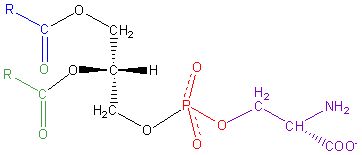Phosphatidylserine (from sunflower lecithin)

COMMON NAME
Phosphatidylserine | PS
TOP BENEFITS OF PHOSPHATIDYLSERINE
Supports brain function and cognitive performance *
Supports mood *
Supports a healthy stress response *
WHAT IS PHOSPHATIDYLSERINE?
Phosphatidylserine is a dietary phospholipid. The best phosphatidylserine food sources are fish and meat. White beans and lecithin are the two best vegan food sources. In the body, phosphatidylserine is found in the internal layer of cell membranes where it supports the function and activity of receptors, enzymes, ion channels, and signaling molecules. Phosphatidylserine is one of the major membrane phospholipids in the brain, accounting for around 13% of the phospholipids in the human cerebral cortex. Phosphatidylserine can be synthesized from another membrane phospholipid, phosphatidylcholine, which in turn can be synthesized from dietary choline or supplement ingredients such as citicoline or alpha-GPC. Human studies on phosphatidylserine have mostly focused on investigating cognitive function, mood, and stress regulation [1].*
NEUROHACKER’S PHOSPHATIDYLSERINE SOURCING
Phosphatidylserine (from sunflower lecithin) is produced from sunflower seeds rather than soy.
Phosphatidylserine (from sunflower lecithin) is concentrated for phosphatidylserine and also contains lesser amounts of other dietary phospholipids including phosphatidylcholine and phosphatidic acid.
Phosphatidylserine (from sunflower lecithin) is non-GMO and vegan.
PHOSPHATIDYLSERINE DOSING PRINCIPLES AND RATIONALE
Dietary intake of phosphatidylserine is estimated to be in the range of 75 to 184 mg a day, with the average daily intake in persons eating a Western diet being about 130 mg. Phosphatidylserine has been used in several clinical studies for the support of cognitive function. Servings have ranged between 200 and 600 mg per day, with 300 mg being a common oral serving when it’s been used on its own. Neurohacker believes phosphatidylserine follows a threshold response (see Neurohacker Dosing Principles) when given to healthy people, which means the majority of functional benefits occur at the lower end of the range. When used as part of a formula with other ingredients, phosphatidylserine is commonly used at amounts ranging from 100 to 300 mg because it may have additive effects and because the lower end of this range, 100 mg, is sufficient to substantially augment dietary intake.*
PHOSPHATIDYLSERINE KEY MECHANISMS
Supports brain function and cognition*
Supports memory and learning* [2–10]
Supports executive function* [2]
Supports mental flexibility* [2]
Supports attention* [4]
Supports number processing and calculation* [11]
Supports cognitive health* [2,5,9,12–15]
Supports acetylcholine release* [13,16–18]
Supports monoamine oxidase B (MAO-B)* [19,20]
Supports brain-derived neurotrophic factor (BDNF)* [12]
Supports hippocampal IGF levels* [12]
Supports the HPA axis* [21,22]
Supports brain glucose metabolism* [23,24]
Supports healthy EEG parameters* [25,26]
Supports healthy mood and stress responses*
Supports positive affect* [6,9]
Supports healthy stress responses* [27]
Promotes exercise performance*
Supports resistance to exhaustion* [28]
Supports healthy stress responses to exercise* [21,22]
Complementary ingredients*
Ginkgo biloba in supporting memory* [29]
DHA in supporting memory and cognitive health* [30,31]*These statements have not been evaluated by the Food and Drug Administration. This product is not intended to diagnose, treat, cure, or prevent any disease.
REFERENCES
[1]H.-Y. Kim, B.X. Huang, A.A. Spector, Prog. Lipid Res. 56 (2014) 1–18.
[2]Y. Richter, Y. Herzog, Y. Lifshitz, R. Hayun, S. Zchut, Clin. Interv. Aging 8 (2013) 557–563.
[3]A. Kato-Kataoka, M. Sakai, R. Ebina, C. Nonaka, T. Asano, T. Miyamori, J. Clin. Biochem. Nutr. 47 (2010) 246–255.
[4]S. Hirayama, K. Terasawa, R. Rabeler, T. Hirayama, T. Inoue, Y. Tatsumi, M. Purpura, R. Jäger, J. Hum. Nutr. Diet. 27 Suppl 2 (2014) 284–291.
[5]T. Cenacchi, T. Bertoldin, C. Farina, M.G. Fiori, G. Crepaldi, Aging 5 (1993) 123–133.
[6]M. Maggioni, G.B. Picotti, G.P. Bondiolotti, A. Panerai, T. Cenacchi, P. Nobile, F. Brambilla, Acta Psychiatr. Scand. 81 (1990) 265–270.
[7]T.H. Crook, J. Tinklenberg, J. Yesavage, W. Petrie, M.G. Nunzi, D.C. Massari, Neurology 41 (1991) 644–649.
[8]S. Schreiber, O. Kampf-Sherf, M. Gorfine, D. Kelly, Y. Oppenheim, B. Lerer, Isr. J. Psychiatry Relat. Sci. 37 (2000) 302–307.
[9]M.I. Moré, U. Freitas, D. Rutenberg, Adv. Ther. 31 (2014) 1247–1262.
[10]A. Kataoka-Kato, M. Ukai, M. Sakai, S. Kudo, T. Kameyama, J. Pharmacol. Sci. 98 (2005) 307–314.
[11]A.G. Parker, J. Gordon, A. Thornton, A. Byars, J. Lubker, M. Bartlett, M. Byrd, J. Oliver, S. Simbo, C. Rasmussen, M. Greenwood, R.B. Kreider, J. Int. Soc. Sports Nutr. 8 (2011) 16.
[12]H.-J. Park, H.S. Shim, K.S. Kim, J.-J. Han, J.S. Kim, A. Ram Yu, I. Shim, Nutr. Neurosci. 16 (2013) 47–53.
[13]S. Suzuki, H. Yamatoya, M. Sakai, A. Kataoka, M. Furushiro, S. Kudo, J. Nutr. 131 (2001) 2951–2956.
[14]J. Corwin, R.L. Dean 3rd, R.T. Bartus, J. Rotrosen, D.L. Watkins, Neurobiol. Aging 6 (1985) 11–15.
[15]B. Lee, B.-J. Sur, J.-J. Han, I. Shim, S. Her, H.-J. Lee, D.-H. Hahm, Prog. Neuropsychopharmacol. Biol. Psychiatry 34 (2010) 1085–1093.
[16]F. Casamenti, P. Mantovani, L. Amaducci, G. Pepeu, J. Neurochem. 32 (1979) 529–533.
[17]F. Casamenti, C. Scali, G. Pepeu, Eur. J. Pharmacol. 194 (1991) 11–16.
[18]F. Pedata, L. Giovannelli, G. Spignoli, M.G. Giovannini, G. Pepeu, Neurobiol. Aging 6 (1985) 337–339.
[19]T.D. Buckman, S. Eiduson, R. Boscia, Biochem. Pharmacol. 32 (1983) 3639–3647.
[20]K.H. Tachiki, T.D. Buckman, S. Eiduson, A.S. Kling, J. Hullett, Biol. Psychiatry 21 (1986) 59–68.
[21]P. Monteleone, M. Maj, L. Beinat, M. Natale, D. Kemali, Eur. J. Clin. Pharmacol. 42 (1992) 385–388.
[22]P. Monteleone, L. Beinat, C. Tanzillo, M. Maj, D. Kemali, Neuroendocrinology 52 (1990) 243–248.
[23]P. Klinkhammer, B. Szelies, W.-D. Heiss, Dement. Geriatr. Cogn. Disord. 1 (1990) 197–201.
[24]W.-D. Heiss, J. Kessler, R. Mielke, B. Szelies, K. Herholz, Dement. Geriatr. Cogn. Disord. 5 (1994) 88–98.
[25]G. Rosadini, W.G. Sannita, F. Nobili, T. Cenacchi, Neuropsychobiology 24 (1990) 42–48.
[26]R.R. Engel, W. Satzger, W. Günther, N. Kathmann, D. Bove, S. Gerke, U. Münch, H. Hippius, Eur. Neuropsychopharmacol. 2 (1992) 149–155.
[27]J. Baumeister, T. Barthel, K.R. Geiss, M. Weiss, Nutr. Neurosci. 11 (2008) 103–110.
[28]M.I. Kingsley, M. Miller, L.P. Kilduff, J. McEneny, D. Benton, Med. Sci. Sports Exerc. 38 (2006) 64–71.
[29]D.O. Kennedy, C.F. Haskell, P.L. Mauri, A.B. Scholey, Hum. Psychopharmacol. 22 (2007) 199–210.
[30]V. Vakhapova, T. Cohen, Y. Richter, Y. Herzog, A.D. Korczyn, Dement. Geriatr. Cogn. Disord. 29 (2010) 467–474.
[31]Y. Richter, Y. Herzog, T. Cohen, Y. Steinhart, Clin. Interv. Aging 5 (2010) 313–316.






